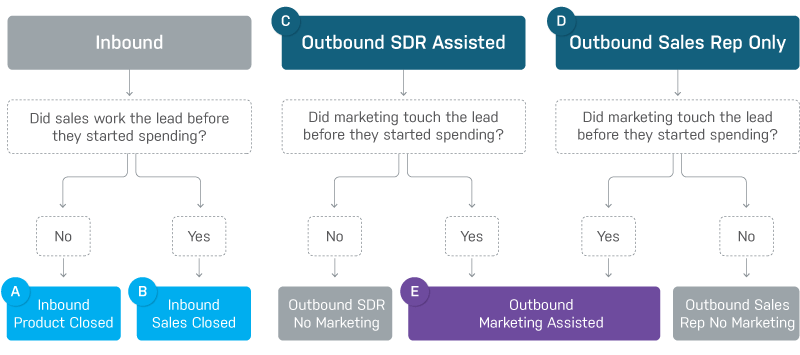When it comes to attribution, many businesses face a huge disconnect between their sales and marketing teams. Contributor Shane Murphy takes a look at the challenge and how to solve it.

Proper attribution is one of the biggest challenges marketers face. I’ve experienced this firsthand in my role as VP of marketing at AdRoll; I’m responsible for reporting on the impact of my team’s marketing efforts and dedicating resources toward the activities that drive the business.
Our customers have the same imperative, which is why they invest in assigning credit to the interactions that generate revenue. A CMO Survey found that 73 percent of businesses plan to increase their spending on marketing analytics in the next three years.
Measurement is vital, but it’s nearly impossible to show the impact of marketing on the business without a cross-functional view. Marketing and sales teams work together to acquire customers, but many marketers — including me, until recently — use attribution models that ignore this reality. These models can account for a number of customer touch points, but they are only complete when they assess the interplay between marketing and sales.
I learned this while building AdRoll’s 2017 acquisition budget with our chief revenue officer, Suresh Khanna. I had a model to measure the return on investment (ROI) of inbound marketing efforts, and he had a model for the ROI of outbound sales efforts. However, these two models weren’t linked. We needed to rethink how we measure marketing and sales at AdRoll, which required expanding our view of attribution. Here’s what I learned from this process:
The disconnect between marketing and sales is an expensive problem
Under the old system, my team was tracking the marketing resources it took to move prospects to conversion, but not how much more revenue we were getting thanks to outreach from sales. Similarly, our sales teams knew how much of their resources it took to clinch a contract, but not the extent to which our marketing efforts helped to close those deals. Meanwhile, using two separate models meant we were often double-counting the impact of marketing and sales, which made our ROI calculations unreliable.
This disconnect isn’t exclusive to our business. A recent survey by Callidus found 84 percent of B2B sales and marketing teams are misaligned. This can cost businesses 10 percent in annual revenue due to missed opportunities and redundant efforts.
Many businesses, including ours, are shifting toward account-based marketing (ABM) to plan more efficiently across marketing and sales and increase profitability overall. Still, the attribution problem remains.
Calculating ROI requires understanding all possible scenarios for closing a deal
In the past, our marketing team measured performance against fairly basic metrics — the number of leads driven by marketing and the revenue that came from those leads. We didn’t take into account whether the lead was truly inbound or already in the sales funnel.
To create a more accurate and integrated model, we needed to analyze exactly how we were closing deals. We mapped out all scenarios for closing a deal (and therefore generating revenue): a lead comes in from marketing and closes without involvement from sales; a sales rep works a lead that has already interacted with marketing; and so forth.
These paths yield five different “buckets” of leads, summarized below:
 Four of these buckets are mutually exclusive and together represent all the ways we close a lead:
Four of these buckets are mutually exclusive and together represent all the ways we close a lead:
- A — Inbound Product Closed (prospect comes to us and signs up through our self-service portal)
- B — Inbound Sales Closed (prospect comes to us and is assisted by a sales rep)
- C — Outbound SDR Assisted (a sales development representative, SDR, reaches out to a prospect and warms the lead before it’s closed by a more experienced rep)
- D — Outbound Sales Rep Only (a sales rep reaches out to a prospect without the assistance of an SDR)
A fifth bucket, E — Outbound Marketing Assisted, is a subset of buckets C and D that shows us the impact of marketing on outbound outreach.
After we came up with these buckets, we set out to compare ROI across them. This required three analyses:
- Categorize all leads worked and closed in a given period within these buckets.
- Figure out the revenue associated with each closed lead.
- Assign a cost per acquisition (CPA) to each closed lead based on the time and money spent by sales and marketing.
We were able to complete these analyses and build a full ROI table with help from our business intelligence team and data from our customer relationship management (CRM) software. If you’re interested in the details of how we did this, you can read more here.
Acquisition attribution is the backbone for goal-setting and reporting
Now that we measure the ROI of our acquisition efforts across different buckets, we can more accurately understand the performance and efficiency of marketing and sales on closing leads. Using this data, Khanna and I work as an acquisition team to set key performance indicators (KPIs) and report on our results to the rest of the organization. We don’t just look at total revenue from inbound vs. outbound outreach; we look at the impact of sales and marketing on each unique buyer path.
Because of our cooperation, we’re better able to invest in areas that result in the greatest impact. For example, we’ve budgeted to ensure our marketing team is assisting on everything in the sales pipeline. We made this decision after our analysis showed us two things we didn’t know:
- An inbound lead through marketing converts at 3x the rate of an outbound lead worked by the sales team, making inbound more efficient.
- If marketing can support sales and warm the outbound lead with marketing, then the conversion rate doubles, improving ROI.
These types of insights have helped us develop a smarter ABM strategy that reflects the reality of our business. Beyond informing budgetary decisions, our attribution analysis shows the business that our marketing team takes ROI seriously.
Marketing continues to evolve as a practice, and attribution is a big part of this shift. Attribution isn’t just about getting credit — it’s also about optimizing activities based on what’s driving revenue to increase profitability. It empowers the team to participate in the strategic conversations that determine the direction of the company.
Some opinions expressed in this article may be those of a guest author and not necessarily Marketing Land. Staff authors are listed here.
Marketing Land – Internet Marketing News, Strategies & Tips
(126)
Report Post





